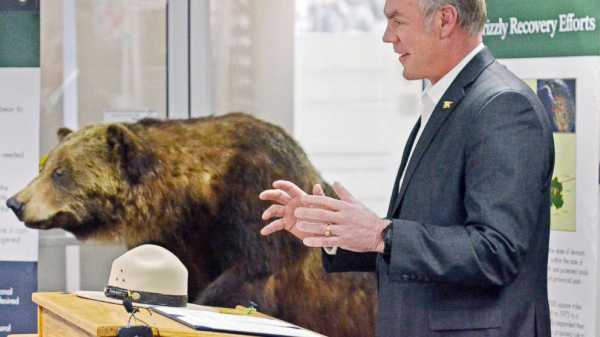
The federal government intends to restore grizzly bears in the remote North Cascade Mountains of Washington state, a goal that represents “the American conservation ethic come to life,” Interior Secretary Ryan Zinke said Friday.
Zinke made the announcement during a visit to North Cascades National Park’s headquarters in Sedro-Woolley, about 75 miles (121 kilometers) north of Seattle.
The Department of the Interior announced in 2014 that it would consider relocating grizzlies to aid their recovery in the Cascades. An environmental review has been underway, but in recent months there have been questions about whether it would continue. Zinke made clear it would, with a formal decision expected by the end of the year.
“Restoring the grizzly bear to the North Cascades Ecosystem is the American conservation ethic come to life,” Zinke said in a news release. “The loss of the grizzly bear in the North Cascades would disturb the ecosystem and rob the region of an icon.”
Numerous grizzlies roamed north-central Washington state in the past, but early settlers and trappers killed thousands for fur in the mid-19th to early 20th century. The region’s booming population has also encroached on their habitat, and few have been seen in recent decades.
The last confirmed sighting of a grizzly in Washington’s North Cascades was by a hiker in 2010. Experts say there may only be about 10 grizzlies in the North Cascades in Washington state, but there is also a population in the mountain range north of the Canadian border.
Options being considered include capturing bears from other locations, including British Columbia and Montana, and releasing them in nearly 10,000 square miles (26,000 square kilometers) of rugged backcountry. Two of the alternatives envision a goal of about 200 bears within 60 to 100 years with smaller initial releases, while a third option would aim to restore 200 animals in 25 years.
A small number of grizzlies live in the Selkirk Mountains of northeastern Washington state, and the bruins have seen big comebacks in other parts of the West, including around Glacier National Park.
Last year, Zinke announced that officials were lifting Endangered Species Act protections for about 700 grizzlies around Yellowstone National Park, opening the door to potential hunting in Idaho, Montana and Wyoming. That decision is being challenged in court by conservation groups and the Northern Cheyenne Tribe.
Conservationists and Indian tribes have long pressed for the government to do more to bring the feared and revered animals back in the Cascades, saying it represents true wildness, and they praised Zinke’s “encouraging words of support.”
Zinke has been under fire from conservationists because he has supported drastically reducing the size of some national monuments in the West, including Bears Ears in Utah. But dozens of demonstrators outside his appearance Friday cheered the news that he supported restoring grizzlies, the Skagit Valley Herald newspaper reported .
“We have never lost hope that the restoration of this American wildlife icon would proceed because the people of Washington have repeatedly demonstrated their overwhelming support for it,” Joe Scott, international programs director for Seattle-based Conservation Northwest, said in a written statement. “People recognize that we’ve forced the grizzly into a small fraction of its former range in four states, including Washington, and that we have a rare opportunity to right that wrong in some small way—and to complete one of the missing chapters of the grizzly bear recovery story.”
The ranching industry was far less enthused.
“Reintroducing as many as 200 man-eating predators into an area already reeling from exploding gray wolf populations is anything but neighborly,” said a statement from Ethan Lane, federal lands executive director with the National Cattlemen’s Beef Association. “This decision won’t just impact ranchers — it’s a blow for the entire North Cascades ecosystem, the safety of locals and visitors, and the local economy, too.”
Sourse: abcnews.go.com






